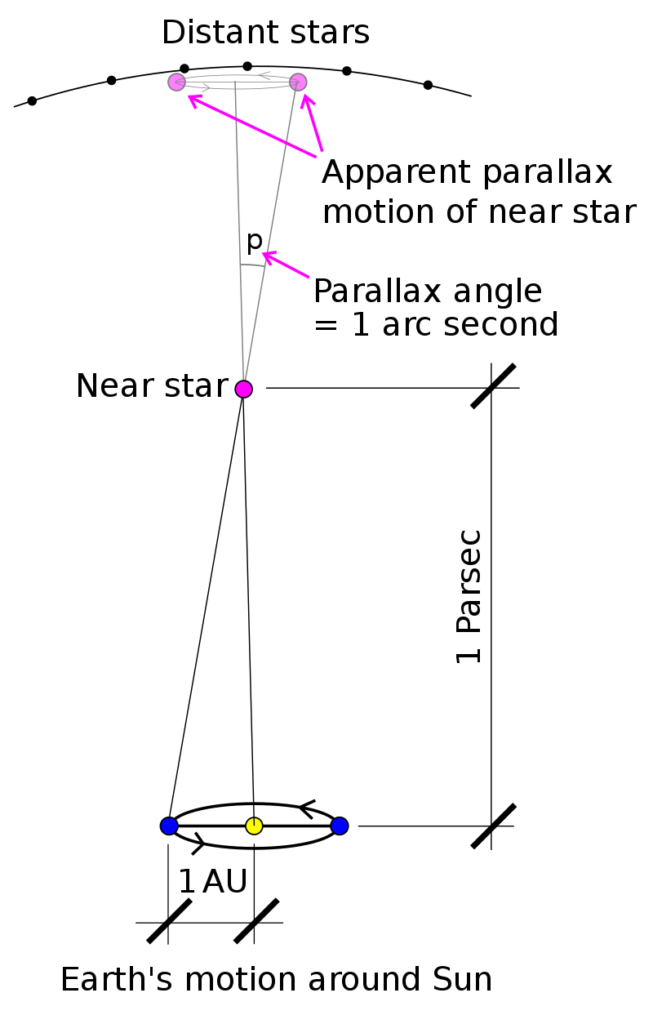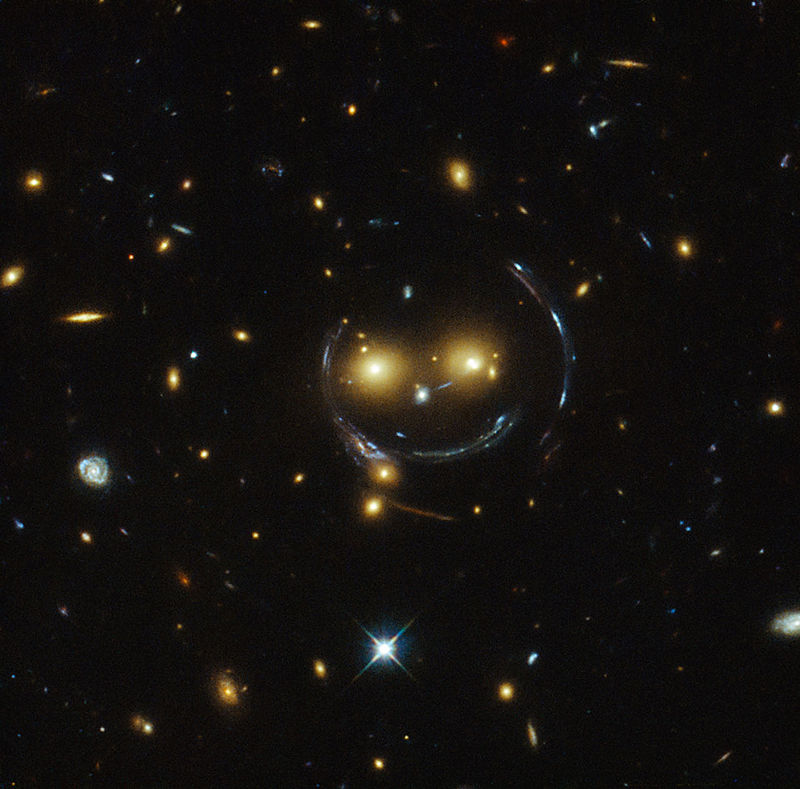If one is to measure the distance between two points here on Earth, one might use some object to scale. Use the scale as a unit of measurement, and report the distance in terms of the scale. If the road is 100 meter-long scales long, then we’d say the road is a hundred meters long.
More advanced techniques employ the use of RADAR or SONAR, where you send out waves of Sound or Light and measure how long it takes for the wave to return, and you can calculate the distance based on that time.
But we can’t apply the same approach to measuring distances to places you can’t reach. You can’t keep stacking up scales to reach the moon. And while RADAR is a better tool to measure distances to the moon, it’s not very feasible since the time taken is half a second. Over short scales, for objects farther away, by the time the light reaches the position you pointed, the object would’ve moved away. Over longer scales, you’d have to wait years, if not millions of years to measure the distance to these objects.
To combat this issue, scientists have been able to come up with a couple of ingenious methods to measure distances to objects in the night sky:
- Parallax Method
- Standard Candles
- Cepheid Variable Stars
- Type 1a Supernovae
- Hubble’s Law and Redshift
Let’s explore each one in depth
Parallax Method
Parallax refers to the apparent displacement or difference in position of an object when viewed along two different lines of sight. This displacement is measured by the angle between those two lines, also known as the half-angle of inclination. Objects that are closer appear to have a larger parallax than those that are farther away. As a result, astronomers can determine distances using parallax, particularly when measuring the distance of planets or stars from Earth.
Astronomers use the principle of parallax to measure large distances. In this case, parallax is the semi-angle of inclination between two sight-lines to the star, as observed when Earth is on opposite sides of the Sun in its orbit. These distances are crucial in what is known as “the cosmic distance ladder”, which is a series of methods used by astronomers to determine distances to celestial objects. Parallax is the first step in this ladder and provides a foundation for other distance measurements in astronomy that make up the higher rungs of the ladder.

From the diagram, you can draw some trigonometric relations. The distance from the Earth to the Sun is known, and the angle is known. From this, you can derive the distance between the star and the sun to be equal to

In astronomical scales, the angle 𝛼 is very tiny, so tan 𝛼 ≈ 𝛼 With this, we can rephrase the above equation to be

Standard Candles
A standard candle is an astronomical object which has a known absolute magnitude. Magnitude is a dimensionless metric used in astronomy to measure the brightness of an object within a specific wavelength range, typically in the visible or infrared spectrum, although sometimes measured across all wavelengths. Hipparchus introduced a method for determining the magnitude of objects in ancient times, which, while imprecise, was systematic.
The magnitude scale is logarithmic, where a star with a magnitude of 1 is 100 times brighter than a star with a magnitude of 6. Each step of one magnitude is approximately 2.512 times brighter than the previous one. The magnitude of an object decreases as it appears brighter, with the brightest objects having negative values.
Astronomers use two different definitions of magnitude: apparent magnitude and absolute magnitude. Apparent magnitude (m) describes the brightness of an object as it appears from Earth and depends on an object’s intrinsic luminosity, distance, and the extinction reducing its brightness. Absolute magnitude (M) describes an object’s intrinsic luminosity and is defined as the apparent magnitude that the object would have if it were at a distance of 10 parsecs from Earth for stars.
The Sun has an apparent magnitude of -27, and Sirius, the brightest visible star, has a magnitude of -1.46. Venus, at its brightest, has a magnitude of -5, while the International Space Station (ISS) can reach a magnitude of -6. Absolute Magnitude and Apparent Magnitude are related by the following formula:

So if we know the apparent and absolute magnitude of an object, we can find out the distance to the object.
Cepheid Variable Stars
A Cepheid variable is a type of variable star that pulsates radially, which causes variations in both its diameter and temperature. These changes in size and temperature result in fluctuations in its brightness, with a stable period and amplitude.
Cepheids are crucial reference points for measuring galactic and extragalactic distances. This is because there is a direct relationship between the luminosity of a Cepheid variable and its pulsation period.
Henrietta Swan Leavitt discovered this feature of classical Cepheids in 1908. She studied thousands of variable stars in the Magellanic Clouds and found that by observing a Cepheid’s pulsation period, its true luminosity could be determined. This information, combined with its observed brightness, allows astronomers to calculate the distance to the star.
The name “Cepheid” comes from the star Delta Cephei, which was identified by John Goodricke in 1784. Delta Cephei was the first Cepheid variable star to be discovered.

Cepheid variable. (2023, March 2). In Wikipedia. https://en.wikipedia.org/wiki/Cepheid_variable
Type 1a Supernovae
A Type Ia supernova, also known as “type one-A,” is a type of supernova that occurs in binary systems where one of the stars is a white dwarf, and the other can be a giant star or even a smaller white dwarf.
Carbon-oxygen white dwarfs with a low rate of rotation have a limit of below 1.44 solar masses, beyond which they can reignite and trigger a supernova explosion. This critical mass is often called the Chandrasekhar mass. If a white dwarf gradually accretes mass from a binary companion or merges with another white dwarf, the core will eventually reach the ignition temperature for carbon fusion as it approaches the Chandrasekhar mass. Within a few seconds of nuclear fusion initiation, a significant portion of the white dwarf’s matter undergoes a runaway reaction, releasing enough energy (10^44 𝐽) to unbind the star in a supernova explosion.
Type Ia supernovae produce a fairly consistent peak luminosity due to the fixed critical mass at which a white dwarf will explode. This consistent peak luminosity makes them useful as standard candles to measure the distance to their host galaxies. The visual magnitude of a type Ia supernova observed from Earth can indicate its distance from Earth.

Type Ia supernova. (2023, February 6). In Wikipedia. https://en.wikipedia.org/wiki/Type_Ia_supernova
Hubble’s Law and Redshift
In 1929, Edwin Hubble made a groundbreaking discovery: almost all galaxies were moving away from us, indicating that the universe was expanding. Hubble observed a redshift in the spectrum of galaxies, which was more prominent in fainter and presumably more distant galaxies, revealing that the farther a galaxy is from Earth, the faster it is receding. This trend is apparent in Hubble’s data, and the velocity of a galaxy can be expressed mathematically using the Hubble constant (H), which is the constant of proportionality. The Hubble constant’s exact value is uncertain, but it is believed to be around 65 kilometers per second for every megaparsec in distance.
To determine the distance of an object, astronomers need only know its velocity, which is measurable using the Doppler shift. By taking the spectrum of a distant object like a galaxy, they can observe a shift in the lines of its spectrum and use this shift to determine its velocity. By plugging this velocity into the Hubble equation, they can determine the object’s distance. However, note that this method of determining distances is based on observation (the shift in the spectrum) and on the theory of Hubble’s Law. If the theory is incorrect, the distances determined using this method would be unreliable. Nevertheless, most astronomers believe that Hubble’s Law holds true for a vast range of distances in the universe.



Leave a Reply